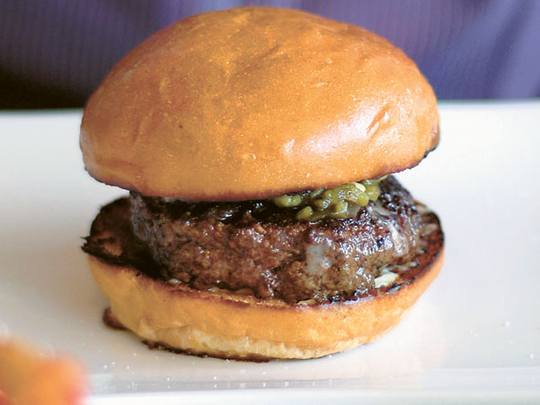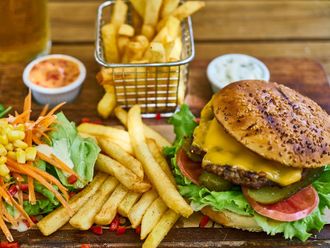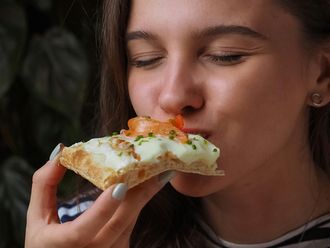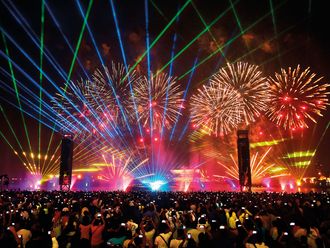
Consider what the burger has been burdened with — poster villain of capitalism and Americanisation of the world. Whipping boy of health experts — a symbol of obesity.
And yet, to call a burger a sandwich seems to do it injustice. For something so vilified, it is fiercely loved, especially in the land it has come to represent — the US. A visit to this country isn't complete without a burger tour. Let us start at the chain store.
The cult-chain burger ($5, or Dh18)
Don't pick any burger chain, though, certainly not one that is a household name around the world. There will be no clowns, kings and yellow stars for us, for we deserve a cult chain. Look for a huge yellow arrow set against a red background and bow down before In-n-Out, one of the most revered food chains in the US.
In-n-Out believes in fresh ingredients. So none of its 240 locations are more than a day's drive from its distribution centre. Californians believe there is nothing on the West Coast that comes close, though some insist that Five Guys is an equivalent. However, White Castle is certainly worth a try for its very different take on the burger.
In-n-Out started in 1948, in Southern California, and is credited with being the first drive-through restaurant. There are no freezers or microwaves, just fresh-baked buns, a never-frozen meat patty and a small choice of condiments. The menu features two variations: a cheeseburger and a double-double (two patties and two slices of cheese).
Additions include a choice of grilled or raw onions, lettuce, tomato, ketchup, mustard and spread. A so-called secret menu offers other options, including the famous "animal style"; shorthand for a hearty version of either burgers or fries. This writer's preference is a "double meat cheeseburger, grilled onions, light spread".
The family burger ($5-$9, or Dh18-Dh33)
If even a regional family chain is too faceless for you, the next stop is the old-time burger house. Frequently called Jim's or Burger Boy these are single locations that serve old-fashioned American food. Because restaurants such as these were essentially stomped out by chains, you can be sure only the best have survived.
A great example is Pie 'n Burger, in Pasadena, California. Started in 1963, the place works almost as a time portal.
Places such as this generally have a signature burger style and usually with the goal of creating a mix of flavours and textures. The crunch of iceberg lettuce offsets the chew of the bun, which, in turn, works with the juiciness of the patty.
There is sweetness from dressing, sour from pickled cucumber, saltiness from the meat, a tiny amount of bitter from mustard and the charred edges of both bun and patty. These burgers are larger and more filling than the cult-chain version.
The chic burger ($8-$14, or Dh29-Dh51)
A fairly recent food trend that is still big in the US is to make fancy versions of regular dishes. Consider the number of gourmet macaroni-and-cheese choices you see at upscale restaurants.
Also, a trend towards local food and specialisation has led to an upsurge of urban, spare and chic burger restaurants or pubs. In Los Angeles and Santa Monica, Father's Office is the place to go for a burger. A dry-aged beef patty is served on a French roll with blue cheese, Gruyere, arugula and an onion compote. Rich.
A similar idea is Umami Burger, with a few branches in Los Angeles. Considering that a beef patty has a strong umami flavour, someone had the great idea of pairing that with four other ingredients: grilled tomato, home-made ketchup, grilled mushroom and a Parmesan crisp.
The result is a burger that tastes strongly of "deliciousness", though some people find it too one-sided.
Another oft-mentioned restaurant in the category, with a branch in Miami and Los Angeles, is the 8oz. Burger Bar. Here, beef is cured in a Himalayan salt-tiled locker to make the house blend mince. The choice of condiments includes red onion marmalade, green peppercorn aioli, fried green tomatoes and charred escarole.
The high-end burger (from $14, or Dh51)
So if burger hierarchy begins with the $1 (Dh4) McDonald's burger, where does it end? Usually in Las Vegas. That is where you can buy several entries from the list of the Top Ten most expensive burgers in the world.
Upscale restaurants use ingredients such as wagyu beef, foie gras, truffles and even gold leaf to create burgers that cost more than $100 (Dh400).
Of similar quality would be the burger served at high-end steakhouses. These are large specimens, made from prime-grade beef patties that are nearly two inches thick.
Wherever you draw your burger boundaries, though, it is unlikely you'll come away without a smile on your face. If the French had invented the burger or if McDonald's had sold bagels, this layered, well-structured dish wouldn't have been burdened with so much guilt.
A burger is beautiful in its taste, symmetry and range of contrasts, and there is a reason deeper than capitalism you can get one, or at least a version of one, in any corner of the world.
Who’s your Umami?
Umami is of the basic tastes, in addition to sweet, sour, salt and bitter. The Japanese loanword translates to "savouriness", though "meaty" and "brothy" are proposed options. Think of the depth of flavour common to mushrooms, soya sauce, grilled tomato, beef broth, Marmite, Parmesan cheese, and, of course, that essence of umami, MSG (monosodium glutamate) or ajinomoto, and you have a pretty good idea of what umami tastes like.
<Your name> goes to White Castle
In the movie Harold and Kumar Go to White Castle, the title burger shop actually exists. It is a regional chain on the West Coast of the US that serves tiny square burgers known as sliders. Three bites and they are gone, making them among the most addictive sandwiches in the world.
The chain, founded in 1921, is probably the oldest existing major burger vendor.
— Gautam Raja is a US-based freelance writer











